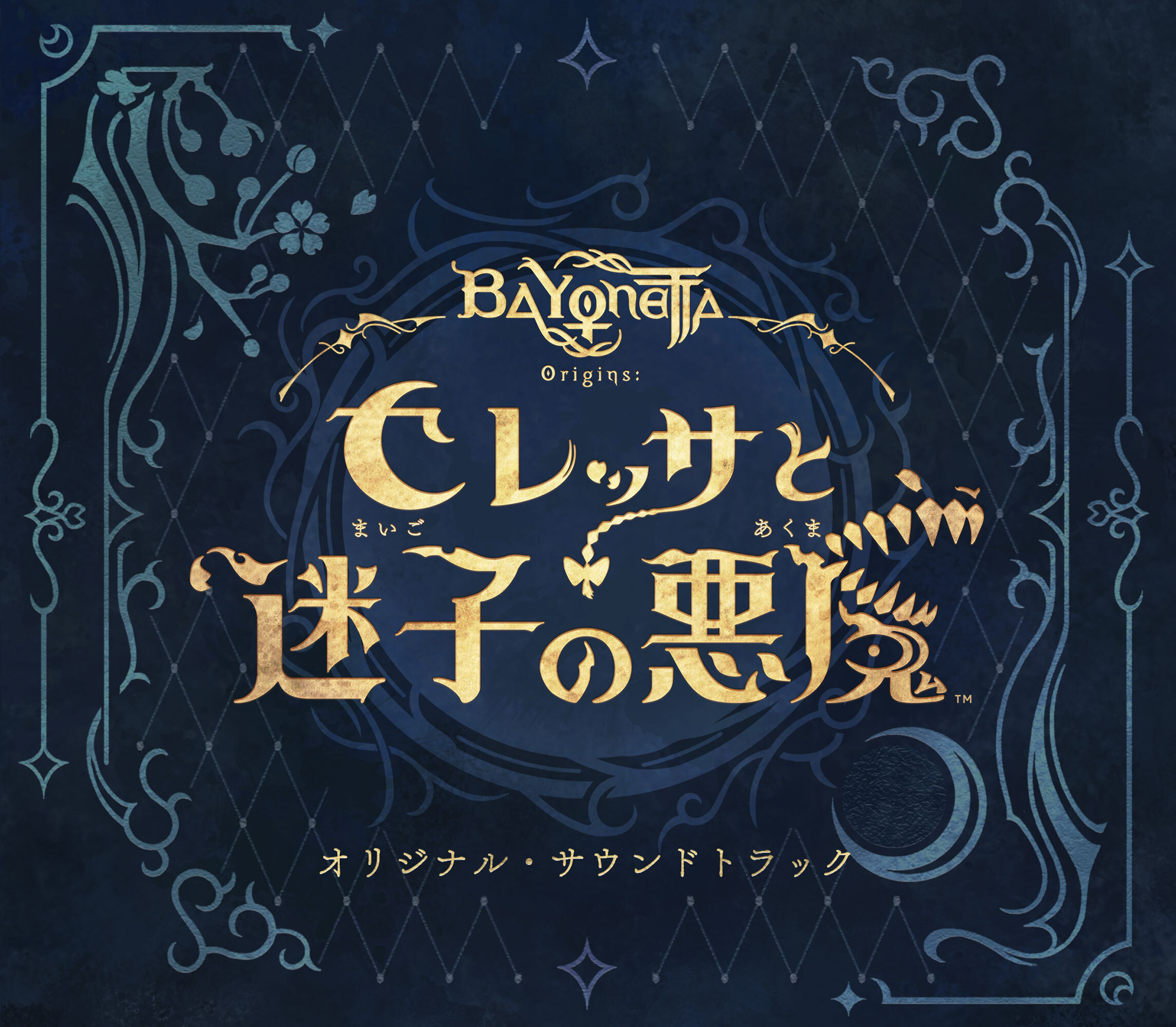So, before we get down to business, I have some exciting news to share with you! I’m happy to say that the Bayonetta Origins: Cereza and the Lost Demon original soundtrack has been announced! (*1)
(*1) Physical soundtrack only available for sale in Japan but ships worldwide from some online retailers. Avaialble to download/stream worldwide.
We’ve been putting our all into this soundtrack, and it will be packed with over one hundred tracks!
The package design was supervised by the game’s art director, Tomoko Nishii (*2), and you can expect it to turn out very cute and picture book-like.♪ If you’re able to, I’d love for you to get your hands on this lovely little treasure filled to the brim with love from all the creators involved.
(*2) Read her blog post here.
Bayonetta Origins: Cereza and the Lost Demon
Original Soundtrack
Release Date: December 20, 2023
Label: WAVE MASTER ENTERTAINMENT
Official Website (Japanese):
https://www.wave-master.com/ent/bayonetta-origins-ost/
Download/stream worldwide: https://nex-tone.link/A00134426_ww
Some services may not currently be available in your region.
Listen to snippets of the soundtrack (Video in Japanese):
Contains some spoilers.
Okay enough of the sales pitch, let’s get onto the topic. In this blog entry, I’d like to introduce you to a few things regarding the memorable Picture Book Cutscenes in Bayonetta Origins: Cereza and the Lost Demon. My name is Rina Yugi and I mainly worked on the music implementation and overall musical supervision for this game, and I even made a few compositions of my own!
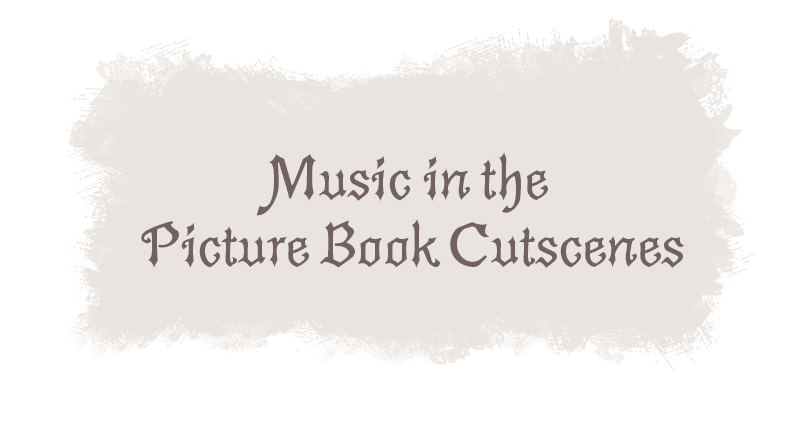

In the picture book cutscenes which you experience in the game, the scenes are portrayed as the pages of a picture book. Each page comes to life before your eyes, as beautiful illustrations with a soft touch emerge and the story unfolds right there on the “paper”. Most of the music that accompanies these pages was written by external composer Ayana Tsujita.
As introduced in the blog post “The Concept behind the Music“, the music for the picture book cutscenes is composed of a quintet consisting of violin 1, violin 2, viola, cello, and piano, and was recorded live. It’s the kind of intimate ensemble that would perfectly accompany a live reading of a picture book!
Our approach to the music for the cutscenes was to first create general-purpose looped tunes that expressed the various circumstances and emotions of the characters. We would then edit and apply the music to each cutscene later, as directed by the music leads Aoba Nakanishi and Hiroshi Yamaguchi. For the opening and ending scenes, Ayana scored the music as a single piece rather than a loop to perfectly match each event being depicted.
She was also kind enough to send us the following message for the blog!

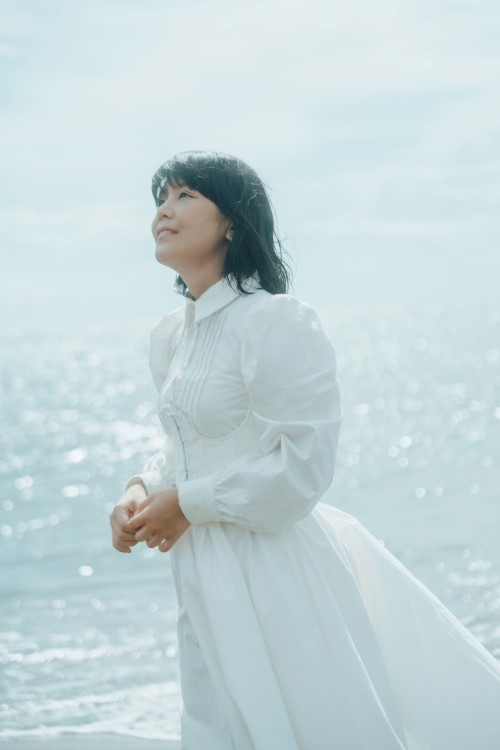 Ayana Tsujita
Ayana Tsujita
Ever since I first heard about this project, I was so excited to take part. Not only was I able to work with a motif I loved—Faeries and Witches—but I also got to work extensively with acoustic music, which further increased my enthusiasm.
Most of the music consists of a piano quintet formation. Since the nature of this composition tends to give off a somewhat old-fashioned flair, I focused on making sure that the music itself would not be merely a well-mannered, run-of-the mill, stereotypical classical score. To create an interesting yet unfamiliar sound with classical instrumentation, I focused on using some unique techniques, such as deliberately bowing the strings of the instruments with force, plucking the piano strings, etc., all of which I wrote onto the musical notation.
Incidentally, the musicians in the quintet all had experience playing in classical and contemporary music concerts! With the help of these talented experts, we believe that we managed to create music that can be described as otherworldly while staying true to the tenets of classical chamber music.
I received specific beat-by-beat instructions for some scenes at the end of the story, but even in scenes that were not specifically designated by the team, I gladly took the liberty of carefully reading the script and designing the music to be similar to a film score. Playing the game after it came out, I noticed that if you turn the page at different times during the cutscenes, the music transitions and escalates in different parts each time. This let me experience the music in a fresh new way, no matter how many times I played through the game.
Another important musical element is that many of the characters are represented by a specific melody or instrument. Some of these leitmotifs have been inherited from past Bayonetta games and were incorporated into the music in various ways. These motifs may also act as clues to understanding parts of the story on a deeper level.
I once saw an analogy: “If you use electricity to boil water, you can’t impart the element of fire.” Digital technology has evolved greatly, and we can create wonderful music without being concerned about the method and tools of creation itself. I feel that in these cutscenes, which dared to go against modern trends and utilize acoustic sound, we created music that shares a certain affinity with the mysterious power of the natural “elements” that appear in the game.
The finished music you hear may not be directly determined by its method of production, but this idea, this focus on the physicality of music, is one of my obsessions as a creator, and I cannot thank PlatinumGames enough for entrusting me with the creation of the music in this way. I am honored to have been involved in a production in which I could feel the commitment and passion of each creator dwell in every corner of the game, including, of course, the music.
Like a witch’s spell, I hope that the invisible power that overflows from the sound will give some power to Cereza and Cheshire in their adventure!
―Ayana Tsujita
What a wonderful message!
As Ayana mentioned, when we asked her to create general-purpose tunes, we picked out the relevant scenes from the scenario, had her read them over, and asked her to compose her score based on her vision of each scene. We only specified a broad, general direction of the music we needed. For example, a “mischievous” tune or a tune that invokes a “sense of crisis”; we left the specifics to her amazing creativity. She was able to create music appropriate for each scene and I feel that she managed to convey Cereza’s feelings in such a rich manner that we were thrilled every time we listened to her demos!
Looping music is often designed to be somewhat subdued, so that it fades into the background and you don’t get tired of listening to it. However, the pieces written by Ayana are both flexible, able to be used in multiple scenes, while also containing a potent sense of drama within each composition which makes them enjoyable to listen to on their own. In fact, I listened to the cutscene tracks hundreds of times each while I implemented and checked them in-game. I enjoyed these tunes as a fresh experience every time, and there were times when I would stop working just to listen to them!
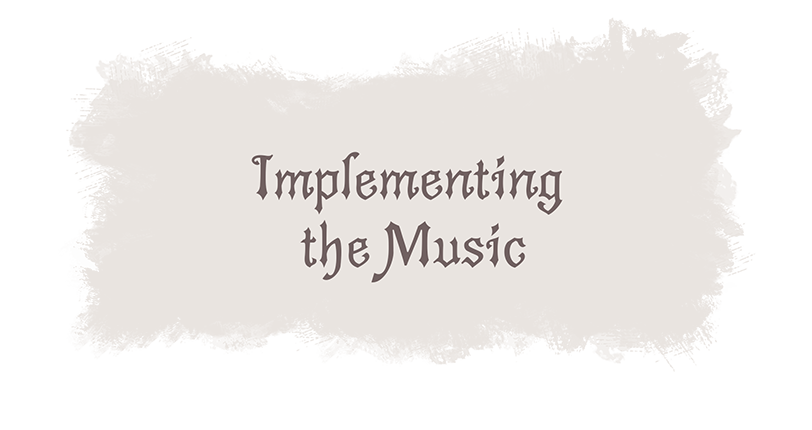

The cutscenes in the game are expressed through a picture book concept. Imagine reading a story book by turning the pages. Simple. Unlike the conventional cutscenes that show the entire story in one connected animation, the story in Bayonetta Origins: Cereza and the Lost Demon is shown as a picture book broken up into discrete scenes – i.e., pages. It is impressive how the colors gradually flow out of the pages and paint a beautiful picture as each page is turned and revealed.
In order to create the experience of reading a picture book, cutscenes were designed in such a way that the player can choose to wait and take in each page after it has finished being drawn in. The next page is turned at the touch of a button, and the following scene begins. Of course, an ”Auto-Play” function is also provided, where the page automatically moves forward each time the story on one page is finished. This is one of the best features and highlights of digital interactive media!
However, the fact that there are different ways of progressing through the pages means that the way the music is played must also be flexible. Since players may choose to manually advance the scenes page by page or choose to have the scenes progress automatically, it is impossible for us to know at what point in the playback of each track they will advance to the next page. In order to synchronize the music with the pictures and have it reach a climax on a particular page, we needed to implement it in a way that can accommodate either progression method.
To provide the same experience regardless of whether players choose to view cutscenes automatically or manually, we did not just use the music in its original form, but edited it in various ways, aiming for an implementation that does not spoil the sense of unity between the pictures and the music (*3). We used the music in a variety of ways, such as extracting only the intro, looping the music in the middle of the track, using only the piano part, and so on. Fortunately, Ayana gave us permission to freely edit and use her music, but we were able to use it in so many different ways that I think some of the scenes may have surprised even her.
(*3) Observant players may have noticed that cutscene “Auto-play” cannot be turned off when watching the opening and ending cutscenes. The score for these scenes is extremely intricate and could not be looped like the other tracks.

Here is a short excerpt of the actual way we implemented the picture book cutscene music when Cereza enters Avalon Forest, encounters the faeries, and summons Cheshire for the first time. You can see this cutscene in the demo version of the game, so make sure you give it a go!
♪Music leading from in-game to picture book cutscenes
Startled by a mysterious presence in the forest, Cereza tumbles off a cliff. Picking herself up, she proceeds fearfully deeper into the forest. What occurs there is a picture book cutscene in which she meets Cheshire.
The uneasy music from in-game continues into the picture book cutscene, and then fades out when the faerie suddenly appears. This piece, entitled “Heart Pounding”, was written by Ayana. In order to effectively show a series of scenes like this, we sometimes start playing the music in-game before transitioning it into the cutscene music, or continue playing the music from the end of a cutscene after the scene ends and players are back controlling the characters.
The reason the music halts so suddenly is because the stop command is linked to the timing (frame) when the faerie appears. This is quite a common technique with game cutscenes. The player is watching the cutscene at their own pace, and when the page progresses and passes this moment, the stop command is triggered to stop the track.
Let’s continue with the cutscene, shall we?
♪Loop in the middle of a track
The track “What Now!?” starts at the cut where the faerie appears, and its name is displayed on the screen. We asked Ayana to read the scenario section of this picture book cutscene and other similar scenes and compose a piece that could be used in this kind of danger-filled situation. The entire piece is a little over a minute long and builds up in tension as it approaches the end. As the piece reaches its climax, the player finds themselves on the edge of their seat, bracing for an incoming attack…And then the track loops back to the beginning.
Before explaining how we implemented this piece, let’s listen to the full version.
♪”What Now!?” full version
Now, if you look at the video again from 00:54, you will see that unlike the full version you just listened to, once you get to a certain part of the track, it begins a mini-loop right before the track builds to its peak. We wanted to time the most exciting climax to the moment when the faeries go in for the attack, so we edited and implemented the track to stay on a shorter loop at the previous phrase so that it does not progress to the climax until that page is turned.
The track is stopped again when Cereza tries to cast her summoning spell. Was the spell successful? Will something appear!? We left this part silent to build suspense.
Let’s look at what happens next.
♪Restarting playback from the middle of the track
We hold our breath…but nothing occurs.
Just as the faeries, who had been flinching for a moment, are about to start moving again, the track begins again from the looped part of the “What Now!?” track that had been playing earlier. The actual moment when the faeries are about to leap toward Cereza is a little further down the page, so the climax will take a little longer.
From 00:32 of the video, we finally reach the page where the faeries jump up and attack Cereza!
At the timing (frame) at the beginning of this page, we put in a command for the track to advance from the looped part of the track to the next climactic part. However, the looped part is not immediately stopped, and the next phrase is played after the command is given. The music is set to switch to the next phrase in one-beat increments so that it still sounds like a single connected piece of music. The rhythm is not broken, and the music proceeds from the loop to the climax of the piece.

Here is another example of how we processed Ayana’s cutscene music to the best of our ability.
♪Music with gradually increasing effects
Note: Voice and sound effects are muted.
Cereza and Cheshire, who are moving through the forest in search of the last Elemental Core, have a shocking encounter along the way. The track “Warmth” begins to play in the middle of that picture book cutscene and continues to play in the in-game portion of the game after the cutscene. The player needs to control Cereza to move forward, but she is in shock and is somewhat unstable as she stumbles forward.
To express Cereza’s emotions, her confusion, and the unbelievable nature of what stands before her, we applied an effect to the music that makes the sound distort as the player moves Cereza closer and closer. At the closest point, the melody is still audible, but the tone is now almost unrecognizable. What was originally a rather gentle and melancholic melody has turned into unsettling discordant noise. The gradual turn to darkness serves to amplify the tragedy of the scene.

We are pleased to release some of the scores in the form of sheet music for the picture book cutscenes we talked about this time! We hope that you will compare the tracks in the game with the music scores and find out how the original pieces were edited and adapted to each scene. We’re sure each of Ayana’s beautiful compositions will touch your heart!
“What Now!?”
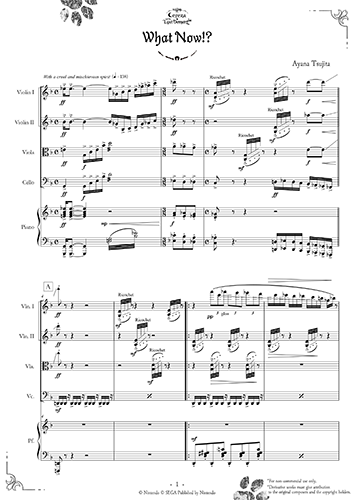 |
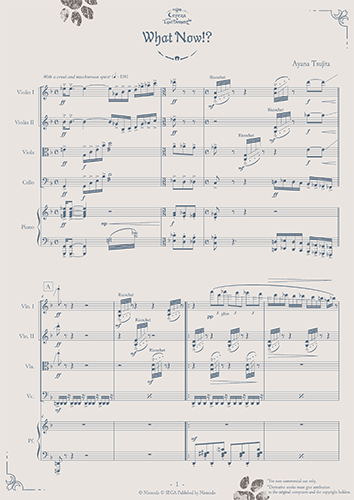 |
♪Listen to the in-game version of “What Now!?”
“Warmth”
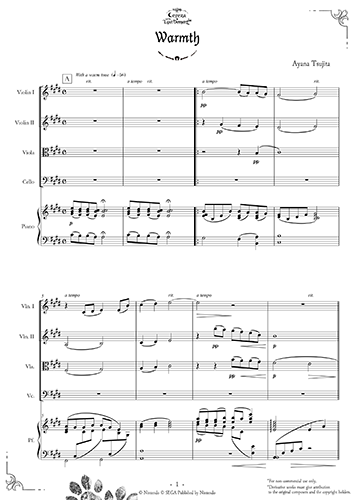 |
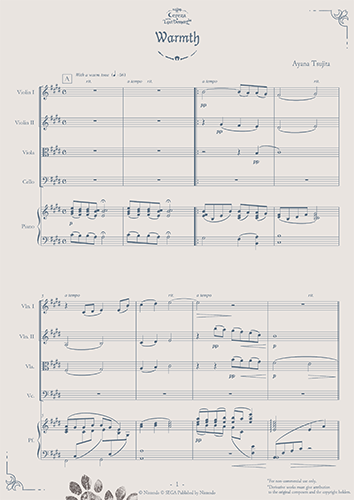 |
♪Listen to the in-game version of “Warmth”
But wait! There’s more!
We are also releasing the score for the track “Girl and Demon” which was introduced in the section “The music when a cutscene is playing” in our previous blog post “The Concept behind the Music“. This is one of the most important pieces of music in the game, as it expresses the relationship between Cereza and Cheshire. I hope you can compare this to the in-game version!
“Girl and Demon”
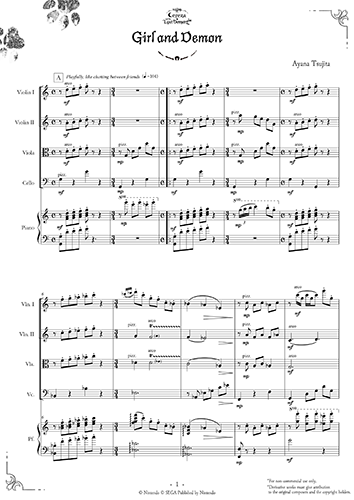 |
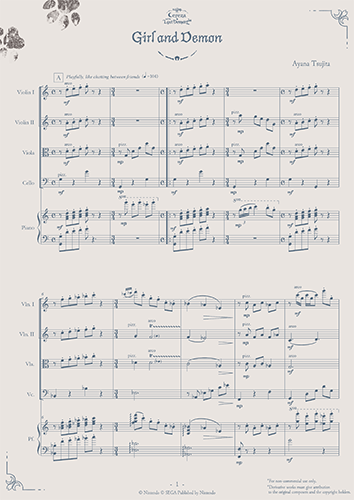 |
♪Listen to the in-game version of “Girl and Demon”

In addition to the cutscenes discussed in this entry, there are many other areas where the music was edited and implemented to fit the various in-game situations. The picture book cutscenes are not the only scenes in which parts of the music are processed or extracted, changing them from their original form.
Some of the music was written with the intention of being played interactively from the beginning, while others required a little bit (occasionally a lot) of creative editing and rejiggering after the fact to fit the needs of the game.
It can be a daunting task to modify an amazing creation that was composed as a single connected piece of music. But I am confident this approach to music implementation makes each scene resonate with players and creates memorable moments that leave a lasting impression.
I would be truly happy if Bayonetta Origins: Cereza and the Lost Demon becomes an experience that stays with you for years to come.
 |
Rina Yugi After graduating from California State University, Rina returned in Japan in 2009 and started working for a major game company, working in arcade games, consumer games, and mobile games. She came aboard PlatinumGames in 2020, and joined the production team for Bayonetta Origins: Cereza and the Lost Demon. |
